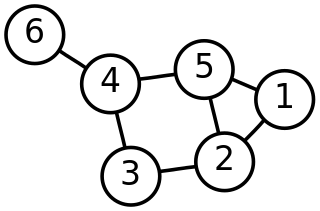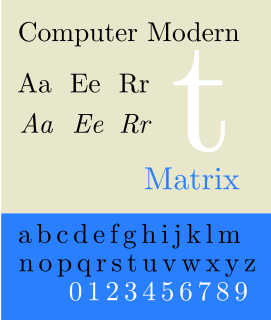
Donald Ervin Knuth is an American computer scientist, mathematician, and professor emeritus at Stanford University. He is the 1974 recipient of the ACM Turing Award, informally considered the Nobel Prize of computer science. Knuth has been called the "father of the analysis of algorithms".

Discrete mathematics is the study of mathematical structures that can be considered "discrete" rather than "continuous". Objects studied in discrete mathematics include integers, graphs, and statements in logic. By contrast, discrete mathematics excludes topics in "continuous mathematics" such as real numbers, calculus or Euclidean geometry. Discrete objects can often be enumerated by integers; more formally, discrete mathematics has been characterized as the branch of mathematics dealing with countable sets. However, there is no exact definition of the term "discrete mathematics".
TeX, stylized within the system as TeX, is a typesetting system which was designed and written by Donald Knuth and first released in 1978. TeX is a popular means of typesetting complex mathematical formulae; it has been noted as one of the most sophisticated digital typographical systems.
Metafont is a description language used to define raster fonts. It is also the name of the interpreter that executes Metafont code, generating the bitmap fonts that can be embedded into e.g. PostScript. Metafont was devised by Donald Knuth as a companion to his TeX typesetting system.

In mathematics and computer science, the floor function is the function that takes as input a real number x, and gives as output the greatest integer less than or equal to x, denoted floor(x) or ⌊x⌋. Similarly, the ceiling function maps x to the least integer greater than or equal to x, denoted ceil(x) or ⌈x⌉.

BibTeX is reference management software for formatting lists of references. The BibTeX tool is typically used together with the LaTeX document preparation system. Within the typesetting system, its name is styled as . The name is a portmanteau of the word bibliography and the name of the TeX typesetting software.

Ronald Lewis Graham was an American mathematician credited by the American Mathematical Society as "one of the principal architects of the rapid development worldwide of discrete mathematics in recent years". He was president of both the American Mathematical Society and the Mathematical Association of America, and his honors included the Leroy P. Steele Prize for lifetime achievement and election to the National Academy of Sciences.

3D tic-tac-toe, also known by the trade name Qubic, is an abstract strategy board game, generally for two players. It is similar in concept to traditional tic-tac-toe but is played in a cubical array of cells, usually 4x4x4. Players take turns placing their markers in blank cells in the array. The first player to achieve four of their own markers in a row wins. The winning row can be horizontal, vertical, or diagonal on a single board as in regular tic-tac-toe, or vertically in a column, or a diagonal line through four boards.
The fractional part or decimal part of a non‐negative real number is the excess beyond that number's integer part. If the latter is defined as the largest integer not greater than x, called floor of x or , its fractional part can be written as:

Computer Modern is the original family of typefaces used by the typesetting program TeX. It was created by Donald Knuth with his Metafont program, and was most recently updated in 1992. Computer Modern, or variants of it, remains very widely used in scientific publishing, especially in disciplines that make frequent use of mathematical notation.

Addison-Wesley is an American publisher of textbooks and computer literature. It is an imprint of Pearson PLC, a global publishing and education company. In addition to publishing books, Addison-Wesley also distributes its technical titles through the O'Reilly Online Learning e-reference service. Addison-Wesley's majority of sales derive from the United States (55%) and Europe (22%).

AMS Euler is an upright cursive typeface, commissioned by the American Mathematical Society (AMS) and designed and created by Hermann Zapf with the assistance of Donald Knuth and his Stanford graduate students. It tries to emulate a mathematician's style of handwriting mathematical entities on a blackboard, which is upright rather than italic. It blends very well with other typefaces made by Hermann Zapf, such as Palatino, Aldus and Melior, but very badly with the default TeX font Computer Modern. All the alphabets were implemented with the computer-assisted design system Metafont developed by Knuth. Zapf designed and drew the Euler alphabets in 1980–81 and provided critique and advice of digital proofs in 1983 and later. The typeface family is copyright by American Mathematical Society, 1983. Euler Metafont development was done by Stanford computer science and/or digital typography students; first Scott Kim, then Carol Twombly and Daniel Mills, and finally David Siegel, all assisted by John Hobby. Siegel finished the Metafont Euler digitization project as his M.S. thesis in 1985.

Knuth reward checks are checks or check-like certificates awarded by computer scientist Donald Knuth for finding technical, typographical, or historical errors, or making substantial suggestions for his publications. The MIT Technology Review describes the checks as "among computerdom's most prized trophies".
In mathematics, the Iverson bracket, named after Kenneth E. Iverson, is a notation that generalises the Kronecker delta, which is the Iverson bracket of the statement x = y. It maps any statement to a function of the free variables in that statement. This function is defined to take the value 1 for the values of the variables for which the statement is true, and takes the value 0 otherwise. It is generally denoted by putting the statement inside square brackets:

Concrete Mathematics: A Foundation for Computer Science, by Ronald Graham, Donald Knuth, and Oren Patashnik, first published in 1989, is a textbook that is widely used in computer-science departments as a substantive but light-hearted treatment of the analysis of algorithms.

The dangerous bend or caution symbol ☡ was created by the Nicolas Bourbaki group of mathematicians and appears in the margins of mathematics books written by the group. It resembles a road sign that indicates a "dangerous bend" in the road ahead, and is used to mark passages tricky on a first reading or with an especially difficult argument.
In mathematics, the Goldbach–Euler theorem, states that the sum of 1/(p − 1) over the set of perfect powers p, excluding 1 and omitting repetitions, converges to 1:
Michael Lawrence Fredman is an emeritus professor at the Computer Science Department at Rutgers University, United States. He earned his Ph.D. degree from Stanford University in 1972 under the supervision of Donald Knuth. He was a member of the mathematics department at the Massachusetts Institute of Technology from 1974 to 1976. and of the Computer Science and Engineering department at the University of California, San Diego until 1992. Among his contributions to computer science are the development of the Fibonacci heap in a joint work with Robert Tarjan, the transdichotomous model of integer computing with Dan Willard, and the proof of a lower bound showing that Θ(n log n) is the optimal time for solving Klee's measure problem in a joint work with Bruce Weide.
Svante Janson is a Swedish mathematician. A member of the Royal Swedish Academy of Sciences since 1994, Janson has been the chaired professor of mathematics at Uppsala University since 1987.

TexLab is a TeX editor based on parallel programming. Contrary to other TeX editors which use a text file as input, TexLab was designed to process small binary document modules. TexLab typesetting engine is implemented by a thread pool to execute MiKTeX commands, such as: LaTeX, XeTeX or pdfTeX. MiKTeX is the version of LaTeX for Microsoft Windows; it consists of a set of tools to process text. Christian Schenk is the creator of MiKTeX, he studied Computer Science at TU Berlin. When Christian owned his first PC, he began working on a fun project; this project eventually became MiKTeX. TexLab interacts with Windows API's and Win32 through a thin level of abstraction provided by the C++ classes of Wintempla. TexLab interacts with MiKTeX commands through Anonymous pipes which is an interprocess communication (IPC) method.












